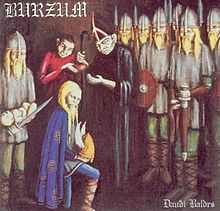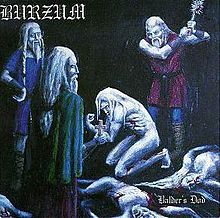- Dauði Baldrs
-
Dauði Baldrs 
Studio album by Burzum Released 1997 Recorded 1994–1995 Genre Dark ambient Length 39:10 Label Misanthropy Producer Varg Vikernes Burzum chronology Filosofem
(1996)Dauði Baldrs
(1997)Hliðskjálf
(1999) cover of the "Balder's død" release of this album
cover of the "Balder's død" release of this albumDauði Baldrs or Dauthi Baldrs (English: "Baldr's Death" or "The Death of Baldr") is an album by the Norwegian artist Burzum. Unlike Burzum's previous work, which was black metal, this is a dark ambient album. It was recorded using a synthesizer and a normal tape recorder by Varg Vikernes while he was in prison, as he was not allowed to have any other instruments or recording equipment. It was completed in a few months due to his limited access to synthesizers, which was also the case with the following album, Hliðskjálf.[1]
Contents
Concept
The album is about the legacy of Baldr, the second son of Odin in Norse mythology. Most likely a concept album, as the whole album leads up to Ragnarok, the battle at the end of the world in Norse mythology.
Music
Stylistically, the album is a mix of medieval music, ambient, neoclassical and minimalism, a huge stray away from the raw black metal that characterized Burzum's earlier work. Some songs are very folk-driven and medieval, while some are sparse, hypnotic ambient minimalist songs, particularly "Illa tiðandi". The songs contrast each other quite a lot, with the title track, "Bálferð Baldrs" and "Í heimr heljar" being the most medieval-like. "Móti Ragnargkum" contains monophonic sections mixed with other thicker sections. "Illa tiðandi" is easily the most minimalist track, with only two sections being repeated over the 10:29 duration, which are both simple piano melodies, which are eventually accompanied by a choral chant.
"Illa tiðandi" is an alternative version of the song "Decrepitude I" while "Bálferð Baldrs" is an ambient version of the main riff from the song "Jesu Død". Both of these songs appeared on Burzum's previous album Filosofem.
"The song "Dauði Baldrs" later got remade as the song "Belus Død"."
Name and release
The album was originally named Baldrs Død. The Misanthropy promo CD sent out before the album's release had this title, as well as a different cover. Furthermore, some copies of the album have a misprint of the Burzum logo, spelling it "Burzu". Rare original pressings of the LP include an eight-page booklet with artwork and Norwegian text as well as a set of six tarot cards.[citation needed]
Track listing
No. Title Length 1. "Dauði Baldrs" ("The Death of Baldr") 8:49 2. "Hermoðr á Helferð" ("Hermóðr on a Journey to Hel") 2:41 3. "Bálferð Baldrs" ("Baldr's Balefire") 6:05 4. "Í heimr Heljar" ("In Hel's Home") 2:02 5. "Illa tiðandi" ("Ill Tidings") 10:29 6. "Móti Ragnarokum" ("Towards Ragnarök") 9:04 Credits
- Varg Vikernes – synthesizers, audio engineering, songwriting
Notes
- ^ "Interview with Varg Vikernes". http://www.burzum.org/eng/library/interview02.shtml. Retrieved 2009-03-05.
External links
Varg Vikernes
Samoth · EuronymousStudio albums Burzum · Det som engang var · Hvis lyset tar oss · Filosofem · Dauði Baldrs · Hliðskjálf · Belus · FallenDemos & EPs Compilation Albums Burzum / Aske · 1992–1997 · Presumed Guilty · Gummo Soundtrack · Anthology · Fenriz Presents... The Best of Old-School Black Metal · Draugen · Lord of Darkness AnthologyCategories:- 1997 albums
- Burzum albums
Wikimedia Foundation. 2010.
